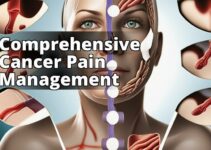I've compiled 13 essential tips for maximizing pain relief with anticonvulsants. From understanding their mechanisms to choosing the right dosage, this article covers everything you need to know to ensure efficacy. With a focus on patient education and monitoring side effects, these tips provide valuable insights for both healthcare professionals and patients. Stay informed about the latest trends and future research opportunities in anticonvulsant therapy for pain management.
Key Takeaways
- Anticonvulsants stabilize abnormal electrical activity in the brain, reducing seizures and potentially providing pain relief.
- Anticonvulsants primarily act on neuropathic mechanisms involved in chronic pain.
- Choosing the right anticonvulsant and considering individual needs and symptoms is crucial for maximizing pain relief.
- Regular monitoring of side effects, adjusting dosage, and considering adjunct therapies can optimize anticonvulsant therapy and improve overall treatment experience.
Understanding Anticonvulsants
I have researched anticonvulsants extensively and can explain their function as medications that work to stabilize abnormal electrical activity in the brain, thus reducing the occurrence of seizures and potentially providing relief from certain types of chronic pain. Anticonvulsants have a significant neurological impact, as they target the central nervous system to prevent and control seizures. These medications work by modulating the transmission of nerve signals, ultimately reducing excessive firing of neurons in the brain. It's important to consider potential drug interactions when using anticonvulsants, as they can affect the metabolism of other medications, leading to either decreased or increased levels of those drugs in the body. Understanding these interactions is crucial to avoid adverse effects and ensure the effectiveness of the prescribed treatment. Therefore, consulting a healthcare professional about potential drug interactions is essential for individuals taking anticonvulsants.
Mechanisms of Pain Relief
Anticonvulsants exert their pain-relieving effects by modulating the transmission of nerve signals, targeting the central nervous system to reduce excessive firing of neurons in the brain. These medications primarily act on neuropathic mechanisms, which are involved in the generation and perpetuation of chronic pain. By affecting specific pharmacological targets, such as voltage-gated sodium channels, calcium channels, and GABA receptors, anticonvulsants can effectively dampen the hyperexcitability of neurons that underlies neuropathic pain. Additionally, some anticonvulsants also modulate glutamate, an excitatory neurotransmitter, further contributing to their pain-relieving properties. Understanding these mechanisms is crucial for tailoring anticonvulsant therapy to individual patients and maximizing their pain relief. It allows for a targeted approach that addresses the specific neurobiological underpinnings of neuropathic pain, ultimately leading to more effective management strategies.
Choosing the Right Anticonvulsant
When choosing the right anticonvulsant, it's essential to consider specific selection criteria that align with individual needs and symptoms. Personalized anticonvulsant treatment is crucial for maximizing pain relief and achieving optimal efficacy. By analyzing the unique factors influencing anticonvulsant selection, we can tailor treatment plans to better address patients' diverse requirements.
Anticonvulsant Selection Criteria
Considering the specific patient's medical history and potential drug interactions is crucial when choosing the right anticonvulsant for pain relief. It's essential to carefully assess the patient's individual needs and circumstances to determine the most suitable medication. When considering anticonvulsant selection criteria, several factors come into play, including:
- Medical history: Understanding the patient's medical background and any previous adverse reactions to medications is essential.
- Drug interactions: Evaluating potential interactions with other medications the patient may be taking to avoid adverse effects.
- Efficacy: Choosing an anticonvulsant that has demonstrated effectiveness for pain relief based on anticonvulsant treatment guidelines.
- Side effects: Considering the potential side effects of the anticonvulsant and how they may impact the patient's overall well-being.
- Dosage form: Selecting a dosage form that aligns with the patient's preferences and lifestyle for improved adherence.
Careful consideration of these criteria is vital for optimizing pain relief and ensuring the safety and efficacy of the chosen anticonvulsant.
Personalized Anticonvulsant Treatment
As a clinician, I prioritize tailoring the choice of anticonvulsant to each patient's unique needs and medical history. Individualized care is crucial in maximizing pain relief through anticonvulsant treatment. When personalizing anticonvulsant treatment, I consider factors such as a patient's age, sex, comorbidities, and potential drug interactions. It's essential to assess the patient's history of response to previous anticonvulsants, as this can guide the selection of the most effective medication. Additionally, understanding the patient's lifestyle and preferences can further aid in choosing the right anticonvulsant. Treatment personalization also involves educating the patient about the potential side effects and benefits of the prescribed anticonvulsant, fostering a collaborative approach to care. By focusing on individualized care and treatment personalization, we can optimize pain relief outcomes for each patient.
Dosage and Titration
How can I determine the appropriate dosage and titration schedule for anticonvulsants to maximize pain relief? It's crucial to tailor the dosage to individual needs and response, considering factors like age, weight, and comorbidities. Here are some key considerations for dosage adjustment and titration strategy:
- Start Low, Go Slow: Initiate with a low dose and gradually increase to minimize potential side effects.
- Regular Monitoring: Schedule regular follow-ups to assess the response and adjust the dosage accordingly.
- Individualized Approach: Consider the patient's pain intensity, previous medication history, and potential drug interactions.
- Titration Schedule: Develop a clear titration plan based on the medication's half-life and the patient's tolerance.
- Patient Education: Educate the patient about the importance of adherence to the prescribed dosage and the potential benefits of gradual titration.
Monitoring Side Effects
When monitoring side effects of anticonvulsants, I prioritize regular assessment to promptly address any adverse reactions. Here's a table detailing common side effects and potential management strategies:
| Side Effect | Management |
|---|---|
| Drowsiness | Adjusting dosage timing |
| Dizziness | Slowly changing positions |
| Nausea | Taking medication with food |
| Mood changes | Therapy alternatives |
Regularly discussing any side effects with my healthcare provider is crucial for effective management. If side effects become intolerable, exploring therapy alternatives or adjusting the dosage may be necessary. Open communication and proactive monitoring are essential for optimizing the benefits of anticonvulsant therapy while minimizing potential side effects.
Comorbidities and Drug Interactions
Since anticonvulsants are commonly prescribed for various conditions, it's essential to consider comorbidities and potential drug interactions to ensure safe and effective treatment. Managing comorbidities and drug interactions is crucial in optimizing anticonvulsant therapy. Here are some key considerations:
- Assessing the patient's complete medical history for comorbid conditions
- Monitoring for potential drug interactions with other medications
- Adjusting anticonvulsant dosages based on comorbidities and interacting medications
- Educating patients about the importance of adhering to their prescribed anticonvulsant regimen
- Collaborating with healthcare professionals to coordinate care for patients with multiple comorbidities and complex medication regimens
Adherence and Compliance
Maximizing pain relief with anticonvulsants requires strict adherence and compliance to the prescribed treatment plan, especially considering comorbidities and potential drug interactions. Improving communication between healthcare providers and patients is crucial for ensuring treatment adherence. Clear and open discussions about the treatment plan, including potential side effects and expectations, can help patients understand the importance of adherence. Additionally, involving patients in shared decision-making processes can increase their commitment to the treatment plan. Healthcare providers should regularly assess and address any barriers to adherence, such as medication costs or concerns about side effects. Furthermore, utilizing tools like medication reminders and simplifying dosing schedules can support patients in staying compliant with their anticonvulsant therapy, ultimately maximizing pain relief.
Assessing Efficacy
After ensuring adherence and compliance to the prescribed treatment plan, I assess the efficacy of anticonvulsants through regular monitoring of pain levels and functional improvements in my patients. This assessment allows me to evaluate outcomes and ensure that the chosen anticonvulsant is effectively managing the patient's pain. To gauge patient satisfaction and treatment efficacy, I often utilize patient-reported outcome measures and conduct thorough discussions with the individual to understand their experiences and any potential side effects. Additionally, I closely observe any changes in the frequency and intensity of seizures, if applicable, to gauge the anticonvulsant's efficacy in managing this aspect of the patient's condition. By employing these methods, I can accurately determine the effectiveness of the anticonvulsant in maximizing pain relief and improving the patient's overall quality of life.
- Monitoring pain levels
- Assessing functional improvements
- Utilizing patient-reported outcome measures
- Conducting thorough discussions
- Observing changes in seizure frequency and intensity
Managing Tolerance and Dependence
I manage tolerance and dependence by closely monitoring my patients' response to the anticonvulsant treatment and adjusting the dosage as needed to maintain efficacy and minimize the risk of dependence. Tolerance management is crucial to prevent the diminishing pain relief effect over time, and dependence prevention is essential to avoid addiction or withdrawal symptoms. To achieve this, I regularly assess the patient's pain levels, side effects, and overall response to the medication. Based on this evaluation, I may gradually increase the dosage if tolerance develops or consider alternative treatment options. Additionally, I educate my patients about the importance of following the prescribed dosage and not exceeding it without medical advice. By actively addressing tolerance and dependence, I aim to maximize pain relief while minimizing potential risks.
| Tolerance Management | Dependence Prevention | Patient Education |
|---|---|---|
| Regular assessment of pain levels and side effects | Monitoring for signs of addiction or withdrawal | Educating patients on medication usage |
Adjunct Therapies
Let's explore the benefits of combination therapy, managing side effects, and ways to enhance the effectiveness of anticonvulsant treatment through adjunct therapies. These points will provide valuable insights into maximizing pain relief and improving overall patient outcomes. By understanding the role of adjunct therapies in anticonvulsant efficacy, we can optimize the treatment approach for better pain management.
Combination Therapy Benefits
Utilizing a combination of anticonvulsant medications has shown significant benefits in enhancing pain relief for many patients. When considering combination therapy benefits, patient outcomes are often improved due to the synergistic effect of using multiple anticonvulsants. This approach can lead to better pain management and increased quality of life for individuals dealing with chronic pain. Moreover, anticonvulsant combinations, when carefully selected, can offer a favorable safety profile, minimizing the risk of adverse effects. The use of multiple anticonvulsants can target pain through different mechanisms, providing more comprehensive relief. Additionally, combining anticonvulsants allows for lower individual dosages of each medication, potentially reducing the likelihood of side effects. This approach underscores the potential of combination therapy in maximizing pain relief and improving patient well-being.
Managing Side Effects
One crucial aspect of managing side effects while using anticonvulsant medications is to explore adjunct therapies that can help alleviate any unwanted symptoms. Managing tolerability and minimizing discomfort are essential for ensuring the effective use of anticonvulsants. In addition to medication, incorporating adjunct therapies can significantly improve the overall experience of treatment. Below is a table highlighting some adjunct therapies that may help in managing side effects:
| Adjunct Therapy | Potential Benefits |
|---|---|
| Acupuncture | Pain relief, relaxation |
| Cognitive Behavioral Therapy | Coping with medication side effects |
| Massage Therapy | Muscle relaxation, stress reduction |
| Yoga | Stress reduction, improved mood |
Exploring these adjunct therapies alongside anticonvulsant treatment can contribute to better overall management of side effects, enhancing the tolerability of the medication and minimizing discomfort.
Enhancing Treatment Effectiveness
Continuing from our previous discussion on managing side effects, I frequently explore adjunct therapies to enhance the effectiveness of anticonvulsant treatment. In improving outcomes and treatment optimization, I find that incorporating adjunct therapies can make a significant difference. Here are some adjunct therapies that can be beneficial:
- Mindfulness meditation: Practicing mindfulness can help in managing pain and reducing stress, ultimately enhancing the overall effectiveness of anticonvulsant treatment.
- Physical therapy: Engaging in physical therapy exercises can improve muscle strength and flexibility, contributing to better pain management and treatment outcomes.
- Cognitive-behavioral therapy (CBT): CBT can assist in changing negative thought patterns and behaviors, leading to improved pain management and treatment efficacy.
- Acupuncture: This alternative therapy has shown promise in alleviating pain and enhancing the effects of anticonvulsant treatment.
- Herbal supplements: Certain herbal supplements, when used in conjunction with anticonvulsants, may offer additional pain relief and optimize treatment effectiveness.
Patient Education and Support
When I educate and support patients regarding anticonvulsant therapy, I emphasize the importance of understanding potential side effects and adhering to the prescribed medication regimen. Patient empowerment and self-management play a crucial role in achieving optimal outcomes. I encourage individuals to take an active role in their treatment by educating them about their condition and the medications they are prescribed. Additionally, I emphasize the significance of utilizing support systems and community resources available to them. This can include seeking out support groups, connecting with others undergoing similar treatment, and accessing educational materials. Empowering patients to actively manage their treatment not only fosters a sense of control but also enhances their overall well-being. By providing comprehensive education and encouraging the use of available support networks, patients are better equipped to navigate their anticonvulsant therapy successfully.
Special Considerations for Elderly Patients
I prioritize educating elderly patients about potential side effects and adherence to their prescribed anticonvulsant medication regimen, as it is essential for their optimal outcomes. When considering anticonvulsant therapy for elderly patients, several special considerations should be taken into account:
- Geriatric Dosing: Adjusting the dosage based on age-related changes in drug metabolism and clearance is crucial to prevent adverse effects and ensure therapeutic efficacy.
- Cognitive Impairment: Recognizing the potential for cognitive impairment is vital, as some anticonvulsants may exacerbate cognitive decline in elderly patients.
- Regular Monitoring: Close monitoring of drug levels and therapeutic effects is necessary due to age-related changes in physiology and potential interactions with other medications.
- Individualized Treatment: Tailoring the choice of anticonvulsant based on the patient's overall health, comorbidities, and potential drug interactions is essential for optimizing pain relief while minimizing side effects.
- Patient Engagement: Engaging elderly patients in shared decision-making and empowering them to communicate any concerns or changes in symptoms is key to ensuring the safe and effective use of anticonvulsants.
Future Trends and Research Opportunities
As a researcher in the field of anticonvulsant therapy, my aim is to identify innovative approaches that enhance the efficacy and safety of these medications. Future trends in anticonvulsant therapy research are focused on personalized medicine, leveraging genetic and biomarker data to tailor treatments to individual patients. Additionally, there is a growing interest in exploring the potential of novel drug delivery systems, such as nanotechnology, to improve the targeting and bioavailability of anticonvulsants. Another promising avenue for research lies in investigating the use of combination therapies and exploring synergistic effects between anticonvulsants and other classes of medications. Furthermore, research opportunities exist in studying the long-term outcomes and safety profiles of anticonvulsants, especially in specific patient populations. By embracing these future trends and research opportunities, we can strive to optimize anticonvulsant therapy and improve the quality of life for individuals living with chronic pain and neurological disorders.




